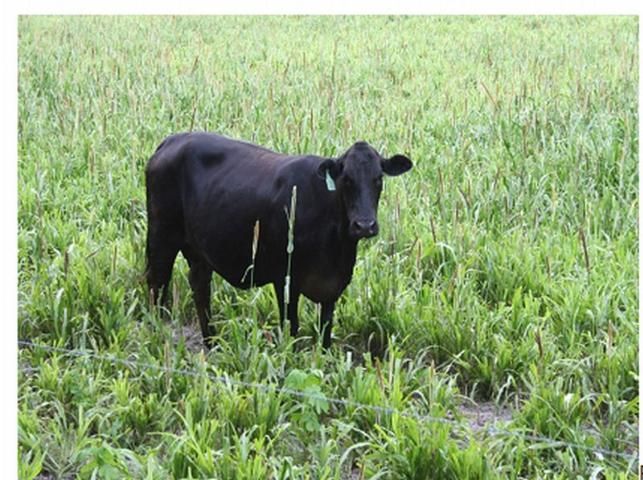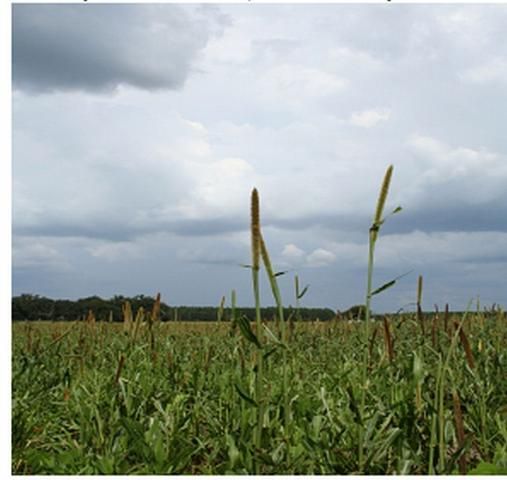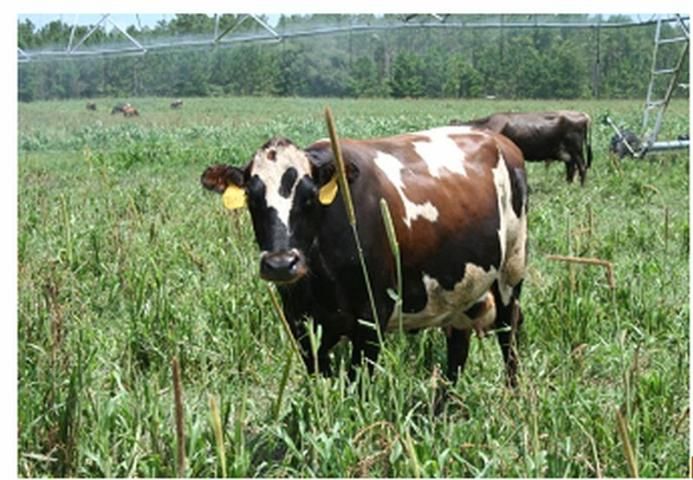Pearl millet is a high nutritive-value summer-annual forage crop, popular among livestock producers for grazing, silage, hay, and green chop. Pearl millet can also be utilized as an emergency forage that regularly performs well as an economical one-year forage crop option.

Credit: UF/IFAS
This summer forage is probably the most drought resistant of the summer grain crops. It prefers well-drained soils, and at the seedling stage, it looks much like a corn or sorghum plant. Compared to sorghum, it is less tolerant of water logging and flooding.
Millet is a broad term used to refer to various small-grain annual cereal and forage grasses of the genera Echinochloa, Eleusine, Panicum, Pennisetum, Setaria, and Sorghum, which—according to use— can be grouped into three broad categories: wildlife or bird-seed (browntop, Japanese, and proso millets), grain, and forage types. This fact sheet will focus on the forage type. Information about other millets can be found at the University of Florida/Institute of Food and Agricultural Sciences (UF/IFAS) Forages of Florida website: http://agronomy.ifas.ufl.edu/ForagesofFlorida/detail.php?sp=Browntop millet&type=G.
Plant Description and Adaptation
Pearl millet is an upright bunch grass that tillers from the base and has an extensive root system that provides drought tolerance. Stems are 1/2–1 inch diameter. It is a leafy plant with leaf blades that are 8–40 inches long and 1/2–3 inches wide. The ligule, or junction of leaf blade to leaf sheath, is a fringe of hairs 0.08–0.1 inch long. The sheath has very sparse hairs at the base of the collar and is often hairless. The inflorescence (flower) is a single raceme—4–20 inches long—that resembles the flower of the aquatic plant known as cattail (see illustration below). The fruit (or caryopsis) is cylindrical, white or pearl in color, or sometimes yellow or brown, and occasionally purple.

Credit: Yoana Newman, UF/IFAS
Pearl millet is best adapted to sandy or light loams and moist but well-drained soils. It has good tolerance to drought. Production season is generally from late May to September.
The crop has a high temperature requirement for growth. The following are the critical temperatures for growth and forage production:
History and Released Cultivars
Pearl millet is originally from Africa. There are mainly two types—tall and dwarf. Dwarf types are leafier types and are used mainly for grazing. Table 1 provides a description of the forage varieties currently used in Florida.
Yield
Dry matter production is highly affected by environmental conditions, such as moisture and soil fertility. When planted during April and fertilized with nitrogen, yield may range from 5,000 to 10,000 lb dry matter/acre (Table 2).
Total yield decreases as seeding date is delayed from earliest planting. For example, in North Central Florida, delaying planting from late March to May is associated with a 10% yield loss, but when planting is postponed to July, losses could be as high as 20%.
Seed yield can range from 225 to 700 lb/acre depending on rainfall and cultivar type. Number of seed per pound ranges from 40,000 to 60,000.
Nutritive Value and Antiquality Factors
Pearl millet is regarded as a high quality feed for grazing, greenchop, hay, or silage. It is high in protein and energy and low in fiber and lignin concentration. Crude protein can range from 9% to 11% in unfertilized soils to 14% to 15% under nitrogen-fertilized conditions.
It is also high in calcium and iron and has balanced amino acids, but sulfur-containing amino acid concentration is low. The forage is readily consumed by livestock when used at vegetative stages.
In situations where the grain is harvested, the nutritive value of the material remaining on the field drops substantially due to low leaf-to-stem ratio of the plants and standing stems that are substantially low in digestibility and nutrient concentration.
One of the advantages of this forage is that it does not produce hydrocyanic acids (like sorghums do), so the poisonous prussic acid does not occur in pearl millet, making it safe to feed to horses. Also, it has no tannins. However, pearl millet can accumulate toxic nitrate levels when nitrogen-fertilized under stressful conditions such as drought, trampling, and cloud cover. Nitrate levels in the dry matter above about 0.9% can be lethal. Milk production can be reduced if nitrate concentration exceeds 0.6% of dry matter. Preservation as hay does not reduce nitrate levels. Once nitrate levels are high at cutting, they remain high in the hay. A different situation occurs for silage, nitrate levels can be decreased by 40%–60% with the ensiling process.
Animal Performance
High quality forage is provided from about June 1 to the middle of September. Reported average daily gains are 1.5 lb/head/day for 700-lb heifers and 445– 470 lb/acre during a 3-month period.
Planting
Having a well-prepared seedbed is critical to avoid weed competition for water and nutrients. The seed germinates and emerges fairly quickly, approximately 5 days after planting. Beginning 14 days after planting, the plant initiates a rapid growth phase.
Site Selection
Selecting the proper site is the first step in establishing a good stand of pearl millet for forage. Pearl millet is best-adapted to well-drained soils that will not hold standing water during summer wet periods. It grows best at soil pH of 6.0–7.0, but it may grow in soil pH as high as 8.0.
Planting Date and Seeding Rates
Pearl millet can be planted over an extended period of time. Planting dates in Florida are generally March through June, although later summer plantings can be effective for short term or emergency forage needs.
Pearl millet seed germination and growth is best when soil temperatures are 68 degrees Fahrenheit or higher, and soil moisture is adequate. The UF/IFAS Florida Automated Weather Network website (FAWN) provides soil temperatures for selected sites in Florida (http://fawn.ifas.ufl.edu/).
Seeding rates are variable, from 12 to 15 lb/acre (planted in rows with a drill) to 30 to 40 lb/acre when broadcast. Lighter seeding rates are preferred for grazing because they result in more shoots per plant (12–15 per plant). Heavy seeding rates result in fewer tillers of finer stem, which is better for hay production. Both broadcasting and drilling are appropriate for seeding methods, but drilling is a more efficient use of the seed, thus cutting down on the amount of seed needed.
Planting in 36-inch row widths (seeding rate of 15 lbs/acre) facilitates cultivation to control weeds, and the width is close enough that plants will close the canopy. Narrower rows may give better yield than wide rows, but wider row spacing allows for better root development.
Management
Fertilizer and Liming Recommendations
Liming is needed only when soil pH is below the recommended target pH of 6.0. Apply lime as needed 3–6 months prior to fertilization to allow for the lime to react with the soil. Test your soil pH every year or at least every other year. Based on your soil test report, the fertilizer recommendations are:
a. Apply 30 lb N/acre, half of the recommended K2O, and all of the recommended P2O5 in a preplant or at-planting application.
b. Apply 50 lb N/acre and the remaining K2O after the first grazing period.
c. Apply an additional 50 lb N/acre after each grazing period.
For additional information about annual summer crops fertilization, see IFAS publication SL 129 UF/IFAS Standardized Fertilization Recommendations for Agronomic Crops (https://edis.ifas.ufl.edu/ss163).
Weed Control
Although pearl millet is a fast-growing forage that may "outgrow" weed competition to some degree, weeds can be a major pest at the slow-growing seedling stage as they compete for light, water, and nutrients. Therefore, good seedbed preparation or preplant weed control is important. Herbicides containing 2,4-D may cause damage to pearl millet stands when high rates are used or when applied at early growth stages (before 21 days of emergence), as it can be damaging to the root system.
For more information, see UF/IFAS publication SS-AGR-08 Weed Management in Pastures and Rangeland (https://edis.ifas.ufl.edu/wg006).
Grazing Management
Grazing of pearl millet is the least expensive way to use this forage. It should be used with animals—such as young, growing animals, lactating dairy cows, or calves under creep grazing—that can respond to the high nutrient levels it contains. This forage is too costly to be used by mature animals or those with low nutrient requirements, unless there is no other feed available to meet maintenance needs.
Pearl millet can be used either under continuous or rotational grazing. However, the most efficient way to use this valuable forage resource is to graze it rotationally.
For most efficient use, animals can be turned into pastures when pearl millet has reached a height of 20–25 inches and removed when stubble height is reduced to 6–8 inches. Stubble heights lower than 4–6 inches may result in delayed and reduced regrowth or death of the plants. Typical rotations in dairy systems under center pivot irrigation paddocks initiate grazing at 20 inches and suspend grazing when at 6 inches stubble height. Depending on stocking rate and paddock size, this is usually accomplished in one day with stocking rates of 3–3.5 animal units/acre (1 animal unit = 1,000 lb). In these systems, paddocks are grazed every 7 days during approximately a 5-month period, depending on how early the millet was planted. Good nutritive value can be maintained with frequent but light grazing.
Continuous stocking can be successfully used, but it must be well managed or it can result in overgrazing in some pasture area or under utilization in others.
Utilization
Hay and Silage
Hay production with pearl millet is possible, but because of the thick stems, expect long curing times. To speed stem drying, a hay conditioner is recommended to crush the stems. Thin-stem types regrow faster after cutting than thick-stem types.
Using a high seeding rate is preferred for hay production because the dense stands reduce the thickness of the stems, which in turn favor shorter drying times. Semi-dwarf hybrids like Tifleaf 3 are recommended for hay production.
Pearl millet that is well fertilized and cut prior to seedhead production will make good quality hay. As with most warm-season grasses, the quality of the forage drops dramatically once seedheads develop.
First cutting is usually at 60–65 days after planting and subsequent cuts should occur at 30- to 35-day frequencies. Regrowth of subsequent cuts declines rapidly.
Plants should be cut when they reach 3 feet high. Yield of pearl millet to successful regrowth is more sensitive to lower stubble height harvest than sorghum. If harvesting for silage, plants should be cut at boot to soft dough stage for optimal nutritive value and wilted before chopping for storage.

Credit: Yoana Newman, UF/IFAS
Pests
Fall army worms can be a problem in pearl millet. Rust (Puccinia substriata) and leaf spot (Pyricularia grisea) are some of the plant diseases that will affect dry matter yield. Good management includes use of quality seed, resistant cultivars, and earlier planting to minimize leaf foliar diseases.
For more information, see UF/IFAS publication EENY098 Fall Armyworm, Spodoptera frugiperda (J.E. Smith) (Insecta: Lepidoptera: Noctuidae) (https://edis.ifas.ufl.edu/in255).
Summary
- Pearl millet is a warm-season plant adapted to well-drained areas typical of Florida's deep sandy soils. It grows well at pH 6.0 and slightly basic (7.0).
- Pearl millet is an annual plant that requires warm temperatures to start production.
- Because of the high nutritive value, this grass is used for growing or lactating animals. In many instances it can be an emergency crop to meet the nutritional needs of the herd.
- Recommended cultivars for grazing include Tifleaf II and Tifleaf III.
- Unlike sorghum, pearl millet is safe for horses.
- Some of the pests include fall armyworm and foliar diseases such as rust or leaf spot.
References
Fontaneli, R., L. E. Sollenberger, and C. R. Staples. 2001. Yield, yield distribution, and nutritive value of intensively managed warm-season annual grasses. Agron. J. 93:1257–1262.
Hanna, W. W., G. M. Hill, R. N. Gates, J. P. Wilson, and G. W. Burton (1997) Registration of Tifleaf 3 pearl millet. Crop Sci. 37:1388.
Hanna, W. W., G. Hill, R. N. Gates, J. P. Wilson, and G. W. Burton. Tifleaf 3 pearl millet. Warm-season grass breeding. http://commodities.caes.uga.edu/grasses/tifleaf3.htm (April 2017)
Hill, G. M., Hanna, W. W, and Gates, R. N. (1999) Pearl millet cultivar and seeding method effects on forage quality and performance of grazing beef heifers. J. Prod. Agric. 12:578–580.
Sellers, B. A., and J. A. Ferrell. 2009. Weed Management in Pastures and Rangeland—2009. SS-AGR-08. Gainesville: University of Florida Institute of Food and Agricultural Sciences. https://edis.ifas.ufl.edu/wg006 (April 2017)
USDA. Agricultural Research Service. Pearl Millet Diseases. http://www.ars.usda.gov/is/np/pearlmillet/witch.htm (April 2017)
Additional Information
Pearl millets, Forages of Florida website: http://agronomy.ifas.ufl.edu/ForagesofFlorida/detail.php?sp=Pearl millet&type=G